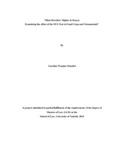| dc.description.abstract | Plant breeding is a significant contributor to the success of any agricultural sector as it is the
source of new, improved and better varieties for cultivation. In Kenya, agriculture is vital as it is
a foreign exchange earner in addition to being a major source of food and employment especially
in the rural areas. As a step towards promoting agriculture through the law and as part of her
international obligations in particular under the TRIPS agreement, Kenya ratified the UPOV
Convention, 1991 Act and domesticated its provisions through the Seeds and Plant Varieties Act.
One of the benefits of the UPOV Convention is that it is a ready legislation and most member
States including Kenya adopted its provisions as they are with minimal or no amendments.
Amongst the provisions adopted in by the Seeds and Plant Varieties Act are the provisions
relating to the DUS test for registration of Plant Breeders’ Rights. The DUS test is uniformly
applied across all Member States when issuing grants of plant breeders’ rights. As the
international governing body for PBRs, UPOV has developed examination guidelines for PBRs
applications and applying the DUS test before issuance of a grant by any Member State. The
uniform application of the DUS test enable Member States to adopt examination reports issued
by the UPOV liaison offices which are the offices administering PBRs in UPOV Member States.
KEPHIS is such cases does not have to undertake the examination process and wholly relies on
such examination report. The uniformity of the application of the test is done against all
applications for all new plant varieties filed at KEPHIS.
This research examines the effect of the uniform application of the DUS test for all new plant
varieties paying specific attention to the food crop and ornamental varieties. These two have
been chosen primarily because of the noticeable differences in the number of reported
applications for registration of PBRs by KEPHIS on an annual basis.
This work is a desktop research and is based on written texts in the form of books, articles and
reports on the subject matter. Amongst the findings by in this research is first that primarily
different varieties have different and unique characteristics and that food crop varieties in Kenya
are mainly developed by the farmers who follow breed for various purposes including sustenance
of the crops on their farms. Food crop varieties especially the ones developed by subsistence
farmers have new and distinct characteristics but they are ordinarily heterogeneous and less
stable. These are the characteristics that make them adaptable to the various environmental conditions that they are cultivated. However, despite being new and distinct, these varieties
would not qualify for protection under the Seeds and Plant Varieties Act as the standards set
under the said Act require a variety no not only be new and distinct but also uniform and stable.
The available texts on the subject matter of this work enumerate the benefits of having PVP in
the form of PBRs in the country. The benefits of applying the international standards for
ornamentals varieties because of the value add for purposes of export. However none of the
available texts explore the effect, presently or would be, for applying these standards to food
crops. The most immediate effect for the uniform application of these standards has been the
dismal number of applications for PBRS for food crops. The other effects include the lack of
recognition and protection under the law of such varieties and plant breeders.
This work has concluded by recommending the adoption of an alternative or differentiated test
for food crop varieties in Kenya which is reflective of the basic nature of the breeding in this
subsector. The alternative test is to be applied against food crop varieties whilst maintaining the
international standard for plant varieties specifically bred for the export market and in particular
the ornamentals. The varied test ensures that the law recognizes all plant breeding at all levels
and by all plant breeders. It is also recognized that protection is not required or is not necessary
for all plant varieties and that intellectual property should not be the only form of protection
available for the breeders in all sectors. In light of this, it is recommended that as a country,
Kenya adopts other forms of recognition and protection of rights of farmers in new plant
varieties they develop such as the ones recommended by African Model Law for the Protection
of the Rights of Local Communities, Farmers and Breeders and the International Treaty on Plant
Genetic Resources for Food and Agriculture (ITPGRFA) which mandates Member States to
offer some form of recognition to farmers and the varieties they have developed and reserved
over the years.
Lastly, it is also recommended that a broad and less restrictive definition of a plant breeder under
the Seeds and Plant Varieties Rights Act be adopted. Since this law is silent on what exactly is
considered as plant breeding, it is suggested that a specific definition of what activities are to be
considered as breeding under the Act be adopted so as to guide in the interpretation of this law. | en_US |

